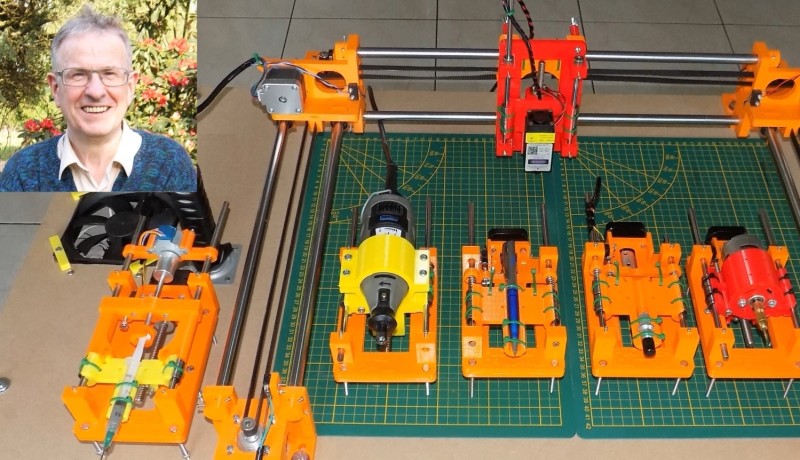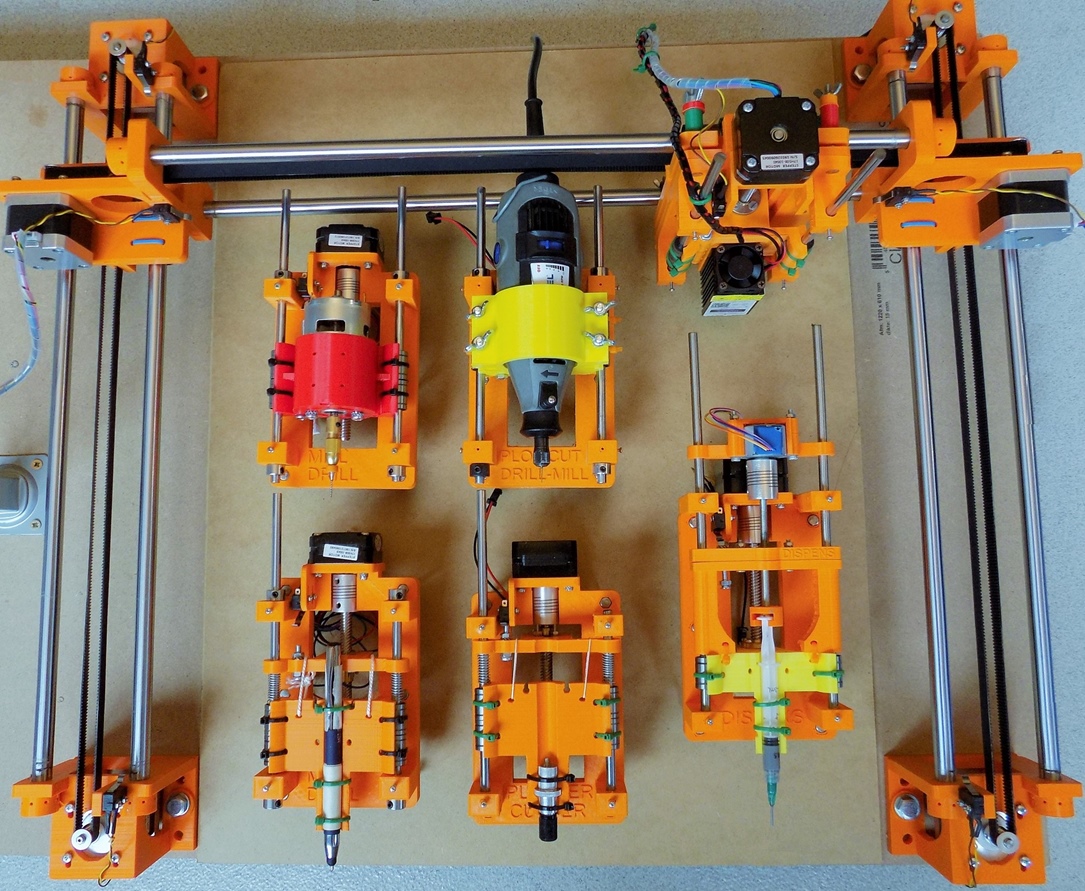Dr. Z99-CNC: A Q&A with José Ganseman
March 06, 2023
on
on

José Ganseman is a passionate and lifelong electronics hobbyist and software programmer who was occupied as a General Practitioner for the past 35 years. Recently, José wrote a book about his Z99 – CNC machine. In this interview, we will explore José’s journey into writing his new book, Build Your Own Multifunctional 4-Axis CNC Machine, learn more about José’s process into creating the CNC machine and how you can use it to create outstanding projects.
Your book, Build Your Own 4-Axis Multifunctional CNC Machine, indicates that you worked as a General Practitioner for 35 years. How much time did you have to devote to your lifetime passion for electronics and software programming while working in another domain?
José Ganseman: For 35 years, working as a general practitioner was always my main occupation. Frankly spoken, this trained me to look at various angles at a problem and to find the best possible solution for it. However, late in the evening and on Sunday, I liked to relax with some studying, programming and prototyping. Believe it or not, we have no television at home.

Can you recollect your first electronic project? Would you mind telling us about it and what technologies were used?
José: At age 14, I was already working on old tube radios. My only resources were some books from the library, a multimeter and a solder gun. A future technological career seemed obvious to me. However, at age 16, I suffered a long medical issue myself, that oriented me to the medical world. I did never regret this choice, but I also followed the electronic developments from the sideline. Weak electronic medical signals (ECG, EEG) were my mean topic of interest. The field of medical electronics is heavily patented and protected. I was lucky to have access to some advanced schematics of ECG and EEG machines. Around 1980, I could build suitable instrumentation amplifiers for ECG and EEG.
When personal computers came along, I realised that these would be very interesting for data acquisition, storage and rendering of medical signals. That is how I got into programming. First, in ‘Basic’ on a TRS80, back in 1981. As soon as I had my personal PC, around 1985, I switched to ‘C’ as my main programming language.
What inspired you to build a multifunctional 4-axis CNC machine?
José: In 2012, I acquired my first 3D printer. In 2017, I managed to build a complete SMD pick-and-place machine with 32 component feeders. This was a challenging task and took quite some time. After the machine was ready, I realised that it could be used for other useful tasks. The Z99 is a scaled-down project from the pick-and-place machine.
What were your objectives when designing the machine? Were all of them successful in the end?
José: The only thing that not succeeded, was to use the Z99 as a 3D giant printer itself. This would be possible, but would require quite a lot of work. The main reason I did not develop this idea further, is that 3D printing is a slow process, even with a print with moderate dimensions. Until now, I could realise all my ideas on a classic 3D printer with a working area of 20×20×20 cm.
In the Preface of your book, you briefly mention the failed prototypes you have built. Can you recount one of the scenarios? What was the problem, and what was the outcome?
José: Most 3D printers work with a single Nema 17 stepper motor for X axis and Y axis. The linear shafts in use are mostly 8 mm diameter. So, I started first with shafts of 8-mm diameter, later with 10 mm. They had a single stepper motor for each axis. Even shafts of 10 mm were not strong enough. We needed to use shafts of 12 mm. One Nema17 motor was then not enough to drive the load. Switching to Nema23 steppers would have been a solution. However, a single Nema 23 stepper and suitable drive is much more expensive than two Nema 17 steppers.
Do you have any advice for people who are having difficulty creating prototypes?
José: It is very interesting to learn how to create and program 3D shapes. ‘OpenScad’ is easy to learn for everybody with some programming knowledge in any language. 3D printers make the creation of things possible, things we could previously only dream of.
Tell us about the process of writing your book. Did you encounter any difficulties?
José: I enjoy building something for personal use. Explaining to other people how to build it, is much more difficult. We owe a lot of thanks to the patient editors at ‘Elektor’. Numerous edits were necessary.
Ultimately, what is the most essential thing you want your readers to learn?
José: If you have an idea, never give up on it. Don’t hesitate to start all over again. A target is the best way to learn new things.
Are you working on anything right now? Do you have any new book ideas?
José: As mentioned above, we build a complete SMD pick and place machine. If this book has some success, we could later make a book about the pick-and-place machine. The machine could also be of use for building a single prototype.
Those who master the task of fine pitch SMD soldering are proud of it and claim that it is not difficult at all. For newbies, it is often a challenging task. It is no wonder that an ‘Arduino’ or even a power hungry ‘Raspberry Pi’ is often used to build a prototype. Nothing bad about these powerful platforms, but it is not real custom work.
Is there an achievement or contribution that you are most proud of?
José Y: Yes, I am proud that ‘Elektor’ has done all the effort to edit and publish my book.
Do you have any other subject/topic on your mind that you would like to you would like to write about?
José: Even on the Internet, quality schematics of electronic medical devices are not available. Maybe, if time allows it, I will try to make an article or even a book about it.
Your book, Build Your Own 4-Axis Multifunctional CNC Machine, indicates that you worked as a General Practitioner for 35 years. How much time did you have to devote to your lifetime passion for electronics and software programming while working in another domain?
José Ganseman: For 35 years, working as a general practitioner was always my main occupation. Frankly spoken, this trained me to look at various angles at a problem and to find the best possible solution for it. However, late in the evening and on Sunday, I liked to relax with some studying, programming and prototyping. Believe it or not, we have no television at home.

Can you recollect your first electronic project? Would you mind telling us about it and what technologies were used?
José: At age 14, I was already working on old tube radios. My only resources were some books from the library, a multimeter and a solder gun. A future technological career seemed obvious to me. However, at age 16, I suffered a long medical issue myself, that oriented me to the medical world. I did never regret this choice, but I also followed the electronic developments from the sideline. Weak electronic medical signals (ECG, EEG) were my mean topic of interest. The field of medical electronics is heavily patented and protected. I was lucky to have access to some advanced schematics of ECG and EEG machines. Around 1980, I could build suitable instrumentation amplifiers for ECG and EEG.
When personal computers came along, I realised that these would be very interesting for data acquisition, storage and rendering of medical signals. That is how I got into programming. First, in ‘Basic’ on a TRS80, back in 1981. As soon as I had my personal PC, around 1985, I switched to ‘C’ as my main programming language.
What inspired you to build a multifunctional 4-axis CNC machine?
José: In 2012, I acquired my first 3D printer. In 2017, I managed to build a complete SMD pick-and-place machine with 32 component feeders. This was a challenging task and took quite some time. After the machine was ready, I realised that it could be used for other useful tasks. The Z99 is a scaled-down project from the pick-and-place machine.
What were your objectives when designing the machine? Were all of them successful in the end?
José: The only thing that not succeeded, was to use the Z99 as a 3D giant printer itself. This would be possible, but would require quite a lot of work. The main reason I did not develop this idea further, is that 3D printing is a slow process, even with a print with moderate dimensions. Until now, I could realise all my ideas on a classic 3D printer with a working area of 20×20×20 cm.
In the Preface of your book, you briefly mention the failed prototypes you have built. Can you recount one of the scenarios? What was the problem, and what was the outcome?
José: Most 3D printers work with a single Nema 17 stepper motor for X axis and Y axis. The linear shafts in use are mostly 8 mm diameter. So, I started first with shafts of 8-mm diameter, later with 10 mm. They had a single stepper motor for each axis. Even shafts of 10 mm were not strong enough. We needed to use shafts of 12 mm. One Nema17 motor was then not enough to drive the load. Switching to Nema23 steppers would have been a solution. However, a single Nema 23 stepper and suitable drive is much more expensive than two Nema 17 steppers.
Do you have any advice for people who are having difficulty creating prototypes?
José: It is very interesting to learn how to create and program 3D shapes. ‘OpenScad’ is easy to learn for everybody with some programming knowledge in any language. 3D printers make the creation of things possible, things we could previously only dream of.
Tell us about the process of writing your book. Did you encounter any difficulties?
José: I enjoy building something for personal use. Explaining to other people how to build it, is much more difficult. We owe a lot of thanks to the patient editors at ‘Elektor’. Numerous edits were necessary.
Ultimately, what is the most essential thing you want your readers to learn?
José: If you have an idea, never give up on it. Don’t hesitate to start all over again. A target is the best way to learn new things.
Are you working on anything right now? Do you have any new book ideas?
José: As mentioned above, we build a complete SMD pick and place machine. If this book has some success, we could later make a book about the pick-and-place machine. The machine could also be of use for building a single prototype.
Those who master the task of fine pitch SMD soldering are proud of it and claim that it is not difficult at all. For newbies, it is often a challenging task. It is no wonder that an ‘Arduino’ or even a power hungry ‘Raspberry Pi’ is often used to build a prototype. Nothing bad about these powerful platforms, but it is not real custom work.
Is there an achievement or contribution that you are most proud of?
José Y: Yes, I am proud that ‘Elektor’ has done all the effort to edit and publish my book.
Do you have any other subject/topic on your mind that you would like to you would like to write about?
José: Even on the Internet, quality schematics of electronic medical devices are not available. Maybe, if time allows it, I will try to make an article or even a book about it.
Read full article
Hide full article



Discussion (0 comments)